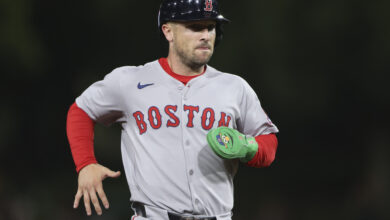
Pocket Radar, Edgertronic Push Baseball Tech to Next Level with ‘Automated Capture System’
Luck is what happens when preparation meets opportunity, which is why some of the most groundbreaking scientific discoveries come from happy accidents. Alexander Fleming discovered penicillin when someone left both a Petri dish and a window open. Pfizer chemists were trying to treat hypertension and angina when sildenafil trials gave rise to a more marketable remedy. Though not related to anything viral or virile, Edgertronic cameras have become indispensable in an unintended market.
“We designed the edgertronic cameras for the expected markets: aerospace, defense, research, manufacturing, etc, so we were a little surprised to see their rapid adoption by MLB,” Mike Matter, Edgertronic founder and CEO, said in a statement. “Now, our cameras are everywhere you go and have become an essential part of the sport. Baseball is big-data, and the technical sophistication of MLB teams should come as no surprise.”
As with any other off-label use, though, there were improvements that could be made to the cameras’ baseball-specific application. Enter Pocket Radar, whose products have been integrated into all levels of baseball over the past decade. Their latest model, the Smart Coach Radar, is the first ever pro-level radar gun and app system, with an interface that combines video with embedded velocity through advanced software designed to create auto-edited video clips.
Those features led Matter to seek out Pocket Radar CEO and co-founder Steve Goody at the MLB Winter Meetings Tech Exposition to find a way to put marry their respective technologies. Thus was born the new Automated Capture System, which combines speed overlay with automatic remote triggering for the Edgertronic camera system. This integration allows users to automatically zero in on specific instances of a pitch’s path to the plate for the first time ever.
“I could not stress enough the importance of providing streamlined technology in baseball,” Goody said of the partnership. “As the game has grown, we have noticed a huge uptick in the creation of new departments at the higher levels of baseball geared towards more advanced technology and analytics. Our new Automated Capture System paired with the Edgertronic cameras will help these departments save massive amounts of time and resources when monitoring player mechanics in high resolution.”
The Pocket Radar team is visiting with select MLB organizations throughout spring training to demo the new Automated Capture System, which can be utilized with new and existing Edgertronic cameras. Though no specific teams have been named, you have to imagine the Cubs are among those who’ll be getting a look at this stuff. Even before they revamped their pitching infrastructure with Craig Breslow at the helm, the Pitch Lab in Mesa was replete with cameras and technology.
While it might seem like a foreign concept to those of us who grew up messing around with grips in the backyard, Edgertronic cameras represent a new frontier for “pitch design.” By capturing high-speed footage of mechanics and results, players and coaches can essentially custom-build pitches from scratch. Rather than just teaching every pitcher to throw, say, a curve or slider a certain way, it’s possible to see what specific grips and releases will yield the best results for each individual.
That goes far beyond just helping prospects reach the majors, since even seasoned veterans need a little help now and then. For example, maybe Jon Lester wasn’t feeling as good about his cutter or change during his side session. The Cubs could zero in to find out with a great degree of certainty whether something was slightly off with his middle finger or his release point that was causing the ball to spin less efficiently.
But no matter how advanced the technology and how clear the images, the real trick to all of this is the interpretation and application of the data. It’s not a matter of a pitcher throwing a curveball and then jumping over to the monitor to analyze it in real time. The coaches tasked with operating these systems need to be able to distill the information into something their pitchers can digest. That can be different for each pitcher, just like the grips discussed above, so a coach’s primary responsibility remains rooted in an understanding of their players.
Even if this isn’t really your jam, it’s pretty exciting if you look at how technology is being used to add new dimensions to the game. And hey, maybe one of those dimensions will involve the Cubs finally breaking the dam holding back their pitching development. Or maybe we’ll just continue to damn their lack of pitching development, though it won’t be due to a lack of data.

